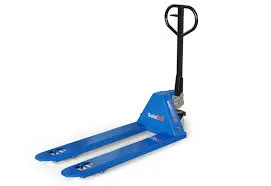


The Design of Pallet Trucks An Essential Asset in Material Handling
Pallet trucks, also known as pallet jacks, serve as an indispensable tool in warehouses, distribution centers, and manufacturing facilities. Their design is the culmination of engineering ingenuity aimed at simplifying the transport of heavy goods on pallets. Understanding the various components and principles behind pallet truck design can provide insights into their functionality and efficiency.
One of the core elements of pallet truck design is the frame. Typically made from robust steel or high-strength aluminum, the frame supports the entire weight of the load. Its design must also ensure stability during operations. A lower center of gravity enhances stability, preventing the risk of tipping, especially when maneuvering through crowded warehouses.
The lifting mechanism is another critical component of a pallet truck. Most conventional pallet trucks utilize a hydraulic system for lifting. This mechanism consists of a hydraulic pump that is activated when the operator pulls the handle. As the operator pumps the handle, the hydraulic fluid pressurizes and lifts the forks. This design allows a single operator to lift loads weighing thousands of pounds with relative ease. Additionally, some modern pallet trucks incorporate electric lifting systems, which can further reduce operator fatigue and increase efficiency in high-volume operations.
The forks, which are the horizontal prongs extending from the frame, are designed with precision to accommodate standard pallet sizes. The fork width is typically adjustable, allowing for compatibility with a variety of pallet designs. A well-designed fork should also offer a slight curvature, enabling the user to easily slide under the pallet. The tips of the forks are often tapered to facilitate smooth entry and exit from pallets, minimizing friction and wear.

Maneuverability is paramount in pallet truck design. The inclusion of swivel castors at the front and rear makes it easier to navigate tight spaces. The wheel design significantly impacts performance; larger wheels can handle heavier loads and uneven surfaces better than smaller wheels. Most pallet trucks utilize polyurethane or rubber wheels to enhance grip and durability. Furthermore, some models come equipped with ergonomic handles and grips to improve comfort for the operator, reducing the risk of strain during prolonged use.
Another key aspect of pallet truck design is safety. Incorporating effective braking systems, such as a parking brake or progressive brakes, ensures stability when the pallet truck is stationary. Additionally, the design should allow for clear visibility of the load being transported, reducing the chances of accidents. Reflective colors or emergency warning labels can also contribute to enhanced safety in busy warehouse environments.
Lastly, maintenance considerations influence design choices. A well-designed pallet truck permits easy access to critical components for routine checks and repairs. Components like wheels, forks, and hydraulic systems should be replaceable, minimizing downtime and prolonging the lifespan of the equipment.
In conclusion, the design of pallet trucks reflects a blend of functionality, safety, and user ergonomics. From the durable frame and efficient lifting mechanisms to the emphasis on maneuverability and maintenance, pallet trucks play a crucial role in streamlining material handling operations. As industries continue to evolve, ongoing innovation in pallet truck design will further enhance their effectiveness, ensuring they remain a vital asset in logistics and supply chain management.



